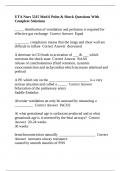NURS 5315 (NURS5315)
University Of Texas - Arlington
All 192 results
Sort by

-
NURS 5315 ADVANCED PATHOPHYSIOLOGY Final EXAM Questions and Answers Latest (2024 / 2025) (Verified Answers) ALL BUNDLED HERE!!!
- Package deal • 11 items • 2024
-
- $24.99
- 5x sold
- + learn more
NURS 5315 ADVANCED PATHOPHYSIOLOGY Final EXAM Questions and Answers Latest (2024 / 2025) (Verified Answers) ALL BUNDLED HERE!!!
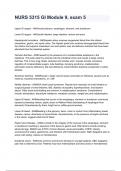 Popular
Popular
-
NURS 5315 GI Module 9, exam 5 already graded A+ 2024/2025
- Exam (elaborations) • 8 pages • 2024 Popular
- Available in package deal
-
- $12.99
- 2x sold
- + learn more
NURS 5315 GI Module 9, exam 5 already graded A+ 2024/2025
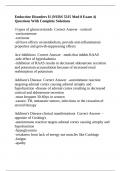
-
NURS 5315 University Of Texas - Arlington -Endocrine Disorders II (NURS 5315 Mod 8 Exam 4) Questions With Complete Solutions
- Exam (elaborations) • 12 pages • 2024
-
- $12.99
- + learn more
NURS 5315 University Of Texas - Arlington -Endocrine Disorders II (NURS 5315 Mod 8 Exam 4) Questions With Complete Solutions

-
N5315 Advanced Pathophysiology Endocrine Core Concepts and Objectives with Advanced Organizers Module 8 Study Guide
- Exam (elaborations) • 24 pages • 2024
-
- $12.00
- + learn more
Endocrine Anatomy and Physiology Analyze the anatomy and physiology of the endocrine system: 1. Examine the production and action of hormones produced by the thyroid, pancreas, and adrenal glands. • Thyroid: ▪ T4 (90%): 1. Released by thyroid gland converted to T3 inside of cell prior to entering nucleus ▪ T3 (10%): 1. more potent, actions are short-lived, present in blood in much smaller amounts than T4 2. stimulates production of the contractile protein a-myosin heavy chain in t...
NURS 5315 University Of Texas - Arlington -UTA Nurs 5315 Mod 6 Pulm & Shock Questions With Complete Solutions
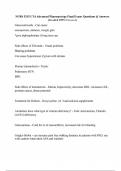
-
NURS 5315 UTA Advanced Pharmacology Final Exam- Questions & Answers (Graded 100% Correct)
- Exam (elaborations) • 8 pages • 2024
-
- $8.00
- + learn more
Glucocorticoids - Can cause: osteoporosis, diabetes, weight gain *give biphosphontate if long term use Side effects of ED meds - Visual problems Hearing problems Can cause hypotension if given with nitrates Flomax (tamsulosin) - Treats: Pulmonary HTN BPH Side effects of testosterone - Edema, hepatoxicity, decreases HDL, increases LDL, prostate cancer, abuse potential Treatment for Rickets - Doxycycline, vit D and calcium supplements Alcoholics have what type of vitamin deficiency? - ...
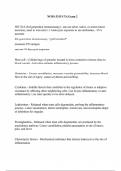
-
NURS 5315 UTA Exam 2
- Exam (elaborations) • 18 pages • 2024
-
- $12.00
- + learn more
HIV EIA (3rd generation immunoassay) - can use urine, saliva, or serum (most accurate), need to wait until 12 weeks post exposure to see antibodies, >99% accurate 4th generation immunoassay- "gold standard" measures P24 antigen can test 10 days post exposure Mast cell - Cellular bags of granules located in loose connective tisssue close to blood vessels. Activation initiates inflammatory process. Histamine - Causes vasodilation, increases vascular permeability, increases blood flow...
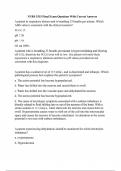
-
NURS 5315 Final Exam Questions With Correct Answers
- Exam (elaborations) • 26 pages • 2024
- Available in package deal
-
- $12.00
- + learn more
A patient in respiratory distress and is breathing 33 breaths per minute. Which ABG value is consistent with the clinical scenario? PCO2 15 pH 7.30 pH 7.45 O2 sat 100% A patient who is breathing 33 breaths per minute is hyperventilating and blowing off CO2; therefore the PCO2 level will be low. The patient will most likely experience a respiratory alkalosis and the two pH values provided are not consistent with this diagnosis. A patient has a sodium level of 115 mEq/L and is disoriente...
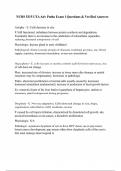
-
NURS 5315 UTA Adv Patho Exam 1 Questions & Verified Answers
- Exam (elaborations) • 67 pages • 2024
-
- $12.00
- + learn more
Atrophy - E. Cells decrease in size P. Still functional; imbalance between protein synthesis and degradation. Essentially there is an increase in the catabolism of intracellular organelles, reducing structural components of cell Physiologic: thymus gland in early childhood Pathological: disuse (muscle atrophy d/ decrease workload, pressure, use, blood supply, nutrition, hormonal stimulation, or nervous stimulation) Hyperplasia - E: cells increase in number, mitosis (cell division) must oc...
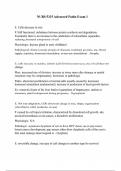
-
NURS 5315 Advanced Patho Exam 1
- Exam (elaborations) • 39 pages • 2024
- Available in package deal
-
- $12.00
- + learn more
E. Cells decrease in size P. Still functional; imbalance between protein synthesis and degradation. Essentially there is an increase in the catabolism of intracellular organelles, reducing structural components of cell Physiologic: thymus gland in early childhood Pathological: disuse (muscle atrophy d/ decrease workload, pressure, use, blood supply, nutrition, hormonal stimulation, or nervous stimulation) - Atrophy E: cells increase in number, mitosis (cell division) must occur, size of c...
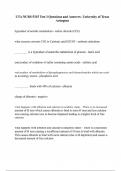
-
UTA NURS 5315 Test 1 Questions and Answers- University of Texas Arlington
- Exam (elaborations) • 17 pages • 2024
- Available in package deal
-
- $13.00
- + learn more
byproduct of aerobic metabolism - carbon dioxide (CO2) what enzyme converts CO2 to Carbonic acid H2CO3 - carbonic anhydrase _________ is a byproduct of anaerobic metabolism of glucose - lactic acid end product of oxidation of sulfur containing amino acids - sulfuric acid end product of metabolism of phosphoproteins and ribonucleotides which are used as an energy source - phosphoric acid __________ binds with 40% of calcium - albumin charge of albumin - negative what happens with albumin ...
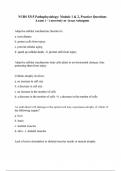
-
NURS 5315 Pathophysiology: Module 1 & 2, Practice Questions Exam 1 - University of Texas Arlington
- Exam (elaborations) • 80 pages • 2024
- Available in package deal
-
- $13.00
- + learn more
Adaptive cellular mechanisms function to: a. treat disease b. protect cells from injury c. prevent cellular aging d. speed up cellular death - b. protect cells from injury Adaptive cellular mechanisms help cells adjust to environmental changes, thus protecting them from injury Cellular atrophy involves: a. an increase in cell size b. a decrease in cell size c. an increase in the number of cells d. a decrease in the number of cells - b. a decrease in the number of cells. An individual...

Do you wonder why so many students wear nice clothes, have money to spare and enjoy tons of free time? Well, they sell on Stuvia! Imagine your study notes being downloaded a dozen times for $15 each. Every. Single. Day. Discover all about earning on Stuvia

